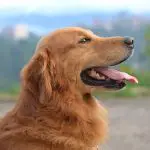Detecting dog bloat
Canine gastric dilatation, commonly referred to as bloat, is a fairly common and potentially fatal medical condition. Bloat occurs when gas accumulates in the dog’s stomach and causes it to become overstretched. Bloat can also involve a twisting of the dog’s stomach, known as volvulus, which leads to very high mortality rates. Volvulus has the potential to close off the esophagus of the dog, preventing it from belching or vomiting, as well as decreasing blood flow to the liver and spleen, often leading to blood poisoning or death by toxic shock.
Bloat can be caused by a number of things; age, breed, stress, and even the shape of the dog’s chest can be bloat-inducing factors. Gastrointestinal disease and inflammatory bowel disease can also increase your dog’s chances of developing bloat. The most common cause of bloat, however, is what and how your dog is eating. It is important to take preventative measures to ensure your dog doesn’t develop canine gastric dilatation. Regular veterinarian check-ups are imperative; while a trained veterinarian can usually treat the situation with surgery, a sudden bad case of bloat can become fatal in a matter of minutes.
Dog bloat isn’t the easiest canine ailment to detect. According to a study conducted by the School of Veterinary Medicine at Purdue University, the breeds most likely to develop bloat are Rottweilers, St. Bernards, Newfoundlands, and Collies. Great Danes, Akitas and Bloodhounds are least likely to develop bloat. Unlike external problems with visible symptoms, internal medical complications may not become noticeable until your dog has developed a serious problem. The most common symptom to be on the lookout for is general distress. Is your dog standing awkwardly or seem to be in pain for no apparent reason? Does it seem depressed or weak? Is it having problems breathing or experiencing weight loss, vomiting or a decreased appetite? These are all basic symptoms for bloat and should act as a red flag for any pet owner. If the dog is in an advanced stage of gastric dilatation it might even show symptoms of shock; pale mucous membranes, poor pulse strength and increased heart rate. A fairly large percentage of dogs also develop cardiac arrhythmias with bloat, a dangerous heart condition that can cause cardiac arrest and even sudden death.
Resuscitation and emergency surgery are often needed for dogs that develop a bad case of bloat. These complicated and dangerous procedures usually involve intravenous fluid therapy, gastrectomy, and passing trocars (sharp, hollow cylinders used to drain high-pressure areas of the body) directly through the skin into the stomach. It is a painful, long process, and does not guarantee that bloat attacks won’t reoccur. Much like a heart attack in humans, dogs with previous bloat attacks, even ones that underwent invasive surgeries, still often develop gas distension of the stomach. Dogs that were treated without surgery are at a much higher risk of having more attacks.
While the dog’s age and breed factors into whether it will develop bloat, there are a few steps you can take to help prevent the occurrence. Studies suggest that dietary factors play a big role in developing bloat, not so much in what the dog is eating but how much and how fast. Dogs that eat a large volume of food once daily are at the highest risk for developing bloat, as are those that eat foods containing a large amount of added oils or fats. This means dogs that are fed too much too fast are being set up for this painful and potentially fatal medical condition. The simple remedy for this is to feed your dog a number of small meals throughout the day, instead of one giant meal in the morning or evening. Slowing down the speed at which your dog eats using a barrier in the bowl or a bowl made specifically for overeating dogs can also be helpful. Another preventative method is to keep your dog’s food bowl at his or her feet. This minimizes not only occurrence of bloat but also stressful situations that could aggravate a current condition. It also helps to not exercise your dog immediately before or after feeding.
Canine gastric dilatation is a very scary medical condition, one that requires a lot of time, money and energy in treating. Luckily, simple feeding techniques, plenty of exercise, and regular veterinary check-ups can help prevent your pooch from developing this painful, debilitating and possibly deadly ailment.


